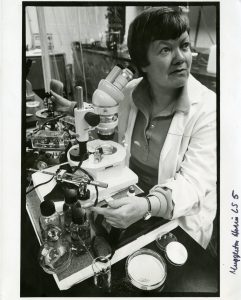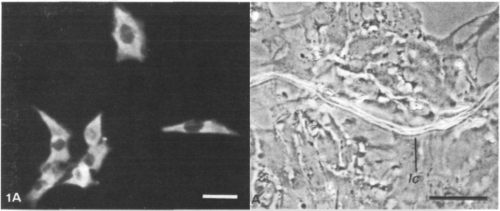First issues – Audrey across the Atlantic
Posted by Joyce Yu, on 13 February 2025
Continuing the ‘First issues’ series, in this post we’ll find out more about Audrey Muggleton-Harris, who published in Development’s first issue in 1987.
Audrey Muggleton-Harris was born in London, England, in 1932. Throughout her prolific career spanning over 40 years, she moved across the Atlantic several times while continuing her research into in vitro systems, early human embryonic development and improvements in assisted reproductive technologies.
While the reasons behind Muggleton-Harris’ multiple relocations are not clear (but probably involved a combination of professional opportunities and personal motivations), moving abroad is still very common, and at times challenging, for academic researchers in the present day. For Muggleton-Harris, the UK and the USA no doubt played a vital role in shaping her professional and personal lives.

Early experiments on nuclear transfer
Muggleton-Harris was originally trained as a teacher, but after reading about the work of cell biologist James Danielli, she joined his team as a research assistant at King’s College London in 1952 [1]. James Danielli was a Director of The Company of Biologists, and helped find a publisher for the previous incarnation of Development – Journal of Embryology and Experimental Morphology (JEEM).
Together, Muggleton-Harris and Danielli performed some of the earliest cloning experiments, first in amoebae [2] and later in frog embryos [3]. They transferred nuclei between cells to test the ability of the transferred nucleus to direct development in a different cytoplasmic environment. These early experiments paved the way for future cloning techniques.
In the early 1960s, Danielli was invited to lead the Center for Theoretical Biology at the State University of New York. Most of Danielli’s group at King’s College London, including Muggleton-Harris, crossed the Atlantic to join him. This move foreshadowed the multiple relocations between the USA and the UK that Muggleton-Harris would make over the next few decades.
In the late 1960s, Muggleton-Harris was a Research Associate at the Institute for Cancer, and then became the Research Director of the Cell Biology program at the Wills Eye Hospital. Muggleton-Harris and her family went back ‘home’ to the UK in 1972 and she worked in Cambridge University. But after just 2 years, they returned to the USA, where Muggleton-Harris was a Research Fellow and Professor of Biology and Biotechnology at Worcester Polytechnic Institute from 1976 to 1983. From 1983 till her retirement in 1997, she would remain in the UK, working at the MRC Experimental Embryology and Teratology Unit in Surrey [1].
Developing in vitro systems to understand development and disease
In her paper in Development issue 1, Muggleton-Harris and co-author N. Higbee found that fragments of the lens capsule, a thin membrane around the eye, could promote mouse lens epithelial cells to synthesize the collagen, glycoproteins and proteoglycan components required for further lens cell differentiation in vitro. This paper was part of a body of work by Muggleton-Harris on culturing mice lens epithelial cells to understand normal lens development and congenital cataracts. Since this Development issue 1 paper, Muggleton-Harris published four more papers in Development during her time working at the MRC in the UK.

Preimplantation development and genetic testing
Her work in lens development was in fact only one part of Muggleton-Harris’ significant contribution to in vitro systems and early development. Almost a decade prior to the Development issue 1 paper, during her two-year stint in Cambridge Univeristy, she published a paper in JEEM in 1976 on ‘surface alloantigens on preimplantation mouse embryos’, investigating immune recognition and compatibility during early development, which is important in understanding maternal-fetal interactions.
In 1982, Muggleton-Harris et al. reported the first successful mammalian transfer of cytoplasm in mice, demonstrating that an unidentified cytoplasmic factor(s) can prevent embryo arrest at the two-cell stage in vitro [5]. In 1988, together with Marilyn Monk and colleagues, Muggleton-Harris developed the trophectoderm biopsy technique in mice [6]. This involved extracting cells from the trophectoderm layer of a blastocyst-stage embryo for preimplantation genetic diagnosis, while minimising damage to the embryo. A few years later, Muggleton-Harris and Findlay tested this method in ‘spare’ human preimplantation embryos in culture [7].
These are just a few examples of Muggleton-Harris’ effort into developing and refining methods for genetic analysis of biopsied cells from preimplantation embryos. Her work has contributed significantly to improving outcomes in assisted reproductive techniques and enhancing the accuracy and safety of preimplantation genetic testing.
An active member of scientific and local communities
Apart from her research, Muggleton-Harris was also a valued member of the scientific community, serving as a committee member of the British Society for Developmental Biology (BSDB) and organising the 1992 BSDB Autumn meeting on the developmental basis of inherited diseases [8].
After many prolific years at the MRC in the UK, Muggleton-Harris retired in 1997 and moved across the Atlantic one last time to Cape Cod, Massachusetts. During her retirement years, according to her obituary [1], she “volunteered as a docent at the Cape Cod Museum of Art… and will be remembered by visitors to the museum as the very proper Englishwoman who led museum tours and the annual historic house and garden bus tours” – a testament to how she left a mark on both sides of the pond, scientifically and socially.
References
[1] https://www.legacy.com/us/obituaries/telegram/name/audrey-harris-obituary?id=12107187
[2] Muggleton A, Danielli JF. Inheritance of the “life-spanning” phenomenon in Amoeba proteus. Exp Cell Res. 1968;49(1):116-120. doi:10.1016/0014-4827(68)90524-7
[3] Muggleton-Harris AL. Cellular changes occurring with age in the lens cells of the frog (Rana pipiens) in reference to the developmental capacity of the transplanted nuclei. Exp Gerontol. 1970;5(3):227-232. doi:10.1016/0531-5565(70)90042-2
[4] A. L. Muggleton-Harris, N. Higbee; Factors modulating mouse lens epithelial cell morphology with differentiation and development of a lentoid structure in vitro. Development 1 January 1987; 99 (1): 25–32. doi: https://doi.org/10.1242/dev.99.1.25
[5] Muggleton-Harris A, Whittingham DG, Wilson L. Cytoplasmic control of preimplantation development in vitro in the mouse. Nature. 1982;299(5882):460-462. doi:10.1038/299460a0
[6] Monk M, Muggleton-Harris AL, Rawlings E, Whittingham DG. Pre-implantation diagnosis of HPRT-deficient male and carrier female mouse embryos by trophectoderm biopsy. Hum Reprod. 1988;3(3):377-381. doi:10.1093/oxfordjournals.humrep.a136711
[7] Muggleton-Harris AL, Findlay I. In-vitro studies on ‘spare’ human preimplantation embryos in culture. Hum Reprod. 1991;6(1):85-92. doi:10.1093/oxfordjournals.humrep.a137264
[8] https://ndownloader.figshare.com/files/12000371; BSDB Newsletter archives



 (No Ratings Yet)
(No Ratings Yet)